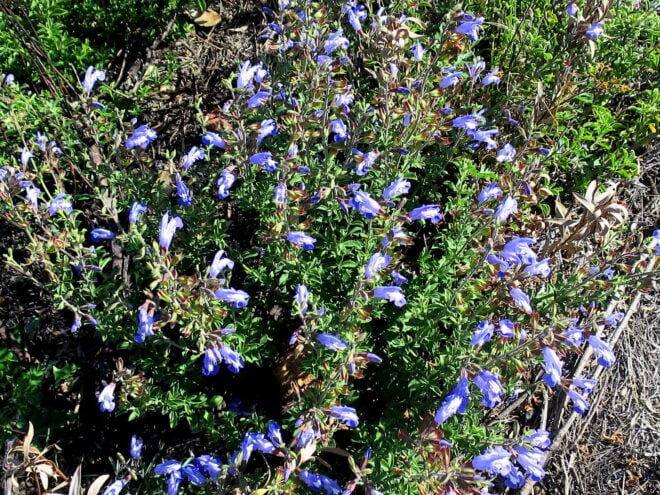
Future-Proof Selections for the Central Valley and Beyond: Winning Choices for Extreme Heat, Cold, and Drought

Contributor
Spring 2023
While sharing the dry summer/wet winter characteristics of a Mediterranean climate common to most of California, the Central Valley faces harsher extremes of heat, cold, and drought – challenges more gardeners across the West coast are experiencing due to climate change.
In times like these, our vision of “right plant, right place” must evolve with the new conditions in our gardens, so wherever you live, you may find some great choices for your landscape here.
University of California, Davis has been the standard for testing and evaluating Central Valley plants for over eighty years . Its “Arboretum All-Stars” program highlights the top performers that are easy to grow, need little supplemental water, disease-resistant, and look consistently beautiful. Many also improve the health of the garden’s ecosystem by attracting beneficial insects and pollinators.
Emily Griswold is the Director of GATEways Horticulture and Teaching Gardens at the UC Davis Arboretum and Public Garden. She shares some of her personal favorite plants for the Central Valley and beyond, from trees to flowering perennials and succulents, including a couple of Arboretum All-Stars. Learn the one tree to plant in the Central Valley for the best environmental benefits, a hummingbird magnet that can reach six feet in a season, and a pollinator friendly ever-gray salvia with clear blue flowers, and more. All these plants have proven themselves in the face of record-breaking heat waves, droughts, and extreme rain events over the last several years.
Emily Griswold’s Plant Recommendations
For more care tips and highlights, see Emily’s Plant Recommendation Page.


Show stopping Flowers for You and the Hummingbirds
Erythrina × bidwillii (hybrid coral bean)
Sun-loving hybrid coral bean is still uncommon in nurseries, but worth seeking out. It pumps out glowing red pea-like flowers from spring through fall, attracting hummingbirds in droves. This deciduous tree or multi-stemmed shrub can reach 18 feet but is typically pruned to grow as a 6-8 foot tall shrub. Blooming continually on new growth it peaks when many other garden plants are tired, and in winter the dry stalks offer fascinating curly architecture .
If You Can Pick Only One Tree to Support Habitat
Quercus lobata (valley oak)
Quercus lobata, commonly called the valley oak, is a foundational plant for regional food webs, supporting countless species of insects, and by extension, birds. The largest California oak, growing up to 100 feet, give them time to achieve their famous majestic and craggy character. Distinctive dark green leaves and furrowed bark add to its appeal. It thrives in areas with year-round access to groundwater or with some supplemental summer irrigation. This Arboretum All-Star is best suited to bigger gardens. Valley oak provides exceptional shade and habitat value in hot summer landscapes.
Painless Desert Design – the Look of a Yucca Without the Barbs
Nolina nelsonii (blue nolina)
Offering luscious blue-gray foliage in the same sculptural rosette pattern as a yucca, blue nolina is a lot easier to garden around. A succulent tree-like shrub from the mountains of Mexico, it takes many years to grow a trunk, and usually gets four feet tall by eight feet wide. Extremely drought and heat tolerant, it grows well in full sun or partial shade with well-drained soil. Its ever-blue color and bold texture add a lot of drama to a low-water-use landscape year-round.

See all of our Pacific Plant People plant recommendations for Drought Resilient and Natives for Habitat here.
This Bee Magnet Lights up the Fall Garden
Leucophyllum langmaniae ’Lynn’s Legacy’ (Lynn’s Legacy Texas sage)
One of the longer-blooming Leucophyllum at the UC Davis Arboretum, this evergreen shrub native to Mexico brings great texture to the garden with velvety gray-green leaves, but it’s the lavender late-summer flowers that you’ll remember. They bloom so profusely that they can obscure the foliage, and usually appear in the summer and fall, typically after a deep irrigation or late summer or early fall rain. This rounded shrub typically grows to 5 feet high and wide and is also an Arboretum All-Star.
A Drought-Resilient Charmer That Fits in Any Sunny Garden
Salvia muirii (wildesalie)
Like all salvias, Salvia muirii is a wonderful pollinator plant – particularly for bees. Its flowers stand out with a charming two-tone effect of blueberry blue and white. Native to the southern coast of South Africa, S. muirii is a remarkably tough and drought tolerant plant. Evergreen and naturally compact with delightfully fragrant leaves, it fits well in small gardens, thriving in sun to partial shade with good drainage


RESOURCES
UC Davis All-Stars Searchable Database
Pacific Horticulture | Drought Roadmap for Gardeners
Pacific Horticulture | Emily Griswold’s Plant Recommendations
Pacific Horticulture | Arboretum All-Stars: Great Plants for Central Valley Gardens
Pacific Horticulture | Challenges of Central Valley Gardening: Creating an All-Star Garden
Pacific Horticulture | Central Valley Gardening, Mediterranean Style









Responses